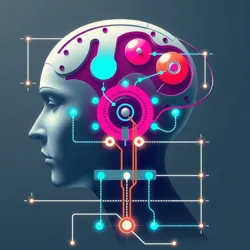Cybernetic Symbiosis
Cybernetic Symbiosis is a theoretical concept that explores the harmonious integration of biological and mechanical systems. It posits a future where humans and machines coexist and cooperate in a mutually beneficial relationship, enhancing each other's capabilities and advancing the frontiers of evolution and technology.
Conceptual Foundations
The idea of cybernetic symbiosis stems from the broader field of transhumanism, which advocates for the use of technology to enhance human physical and cognitive abilities. It draws inspiration from natural symbiotic relationships, where different species interact in ways that benefit both parties. In the context of cybernetics, this interaction involves the seamless integration of human and machine elements to create more capable and adaptable entities.

Image: Conceptual depiction of a cybernetic interface, illustrating the integration of biological and technological elements.
Applications and Examples
Cybernetic symbiosis is explored across various fields, including medicine, robotics, and artificial intelligence. Some notable applications include:
-
Medical Prosthetics: Advanced prosthetic limbs that interface directly with the nervous system, allowing for natural control and sensory feedback. These devices exemplify the principles of cybernetic symbiosis by enhancing the wearer's capabilities in a way that mimics natural function.
-
Robotic Companionship: Development of robotic entities that can interact with humans in emotionally supportive ways, such as the Silicon Hive inhabitants who use digital slang to communicate.
-
Neural Interfaces: Technologies that allow direct communication between the human brain and machines, facilitating new forms of interaction and control. This concept is closely associated with pursuits by the Tattooed Evolutionaries, who embed circuits into their skin.
Challenges and Considerations
While the potential benefits of cybernetic symbiosis are vast, several challenges must be addressed to realize its full potential:
-
Ethical Implications: The integration of machines into human bodies raises questions about identity, autonomy, and the nature of humanity. These concerns echo those faced by the Tattooed Cyborgs and their body modifications.
-
Technological Limitations: Current technology must evolve to support the complex interactions required for true symbiosis. Research into adaptive materials and AI is ongoing to overcome these barriers.
-
Social Acceptance: As with any transformative technology, societal acceptance is crucial. Public perception of cybernetic enhancements is influenced by cultural norms and media portrayals, such as those seen in the Biomechanical Hive.
Future Prospects
The future of cybernetic symbiosis is promising, with ongoing research and development in multiple disciplines. As technology advances, the boundary between biological and mechanical systems is expected to blur further, leading to new forms of cooperation and cohabitation. This evolution could pave the way for the establishment of cybernetic communities, where humans and machines coexist in ways that enhance both individual and collective capabilities.
See Also
References
- "The Rise of Cybernetic Symbiosis," Cyberskin Chronicles.
- "Tattooed Cyborgs and the Future of Body Art," Cyberskin Chronicles.
- "Exploring the Silicon Hive: A Model for Human-Machine Interaction," Cyberskin Chronicles.
Cybernetic symbiosis represents a bold vision of the future, where the integration of technology and biology leads to unprecedented advancements in human and machine capabilities. As research continues to unfold, the potential for transformative change in how we live, work, and interact with the world around us remains a compelling area of exploration.